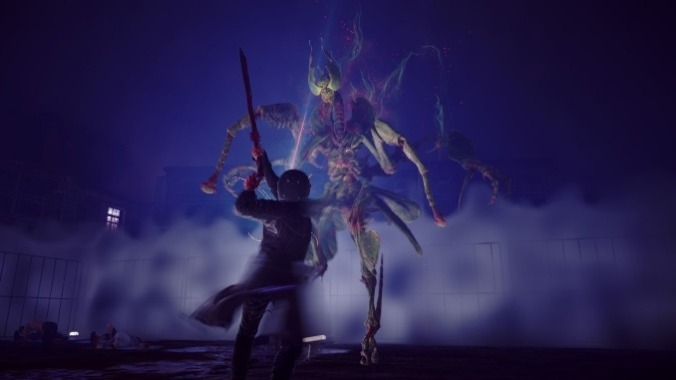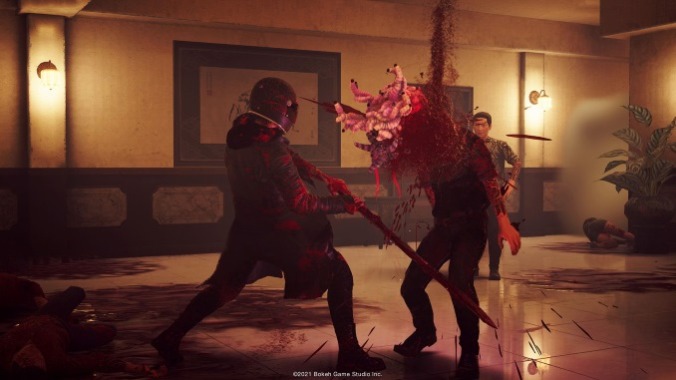
Slitterhead isn’t at all what I expected, and that’s a good thing. Developer Bokeh Studio, a group consisting of some of the developers behind the Silent Hill, Siren, and Gravity Rush series, amidst other projects, has chosen body horror and grittiness to paint the world of its first game. Instead of a slow-paced survival horror experience, the brush has a blunt force to it, introducing itself as a third-person action game with a plethora of promising, gruesome twists.
During a hands-on demo at Summer Game Fest 2024, I was able to play Slitterhead for about an hour. My time with it was split into two, starting at the very beginning of the game and then jumping to a later point in the story. Things kicked off controlling a being without physical form, as well as, of course, amnesia. Controlling it as a floating entity, I commandeered the body of a stray dog to make my first steps into the fictional 1990s city of Kowlong.
This isn’t Stray, however, and it’s rather in line with the main mechanic of Watch Dogs Legion, where you’re able to take control of most NPCs you come across. In Slitterhead, this is done by pressing L1, which freezes time and gives you the chance to aim at a different host. The camera then zip zaps toward it, and you’re living and breathing as somebody else. Until they inevitably get brutally massacred by the namesake creatures.
Slitterheads are parasites of sorts that inhabit the citizens of Kowlong in disguise. Until you have the misfortune of encountering one of them up close, that is. In a similar fashion to the teaser trailer, I witness the first appearance of these monsters in a dark alleyway, as a woman’s neck opens up like a flower to uncover a terrifying pile of flesh coming from inside the body. She quickly begins a chase, which forces me to quickly chain-possess between multiple NPCs right before they get sliced up in two. This sequence is also an indicator of another design pillar of the experience: most of the people you control are deliberately expected to die.
In an interview with IGN, Bokeh Studio’s CEO and creator Keiichiro Toyama said that he made a point about this design decision in the game’s proposal, writing that “the human body is weak and should be disposed of as you fight.” Despite that expectation, the characters you control tend to have different feels to them based on their age and circumstance. An old person can barely jog, for example, while a younger NPC moves faster. These subtle differences are more noticeable during combat, but overall, controlling a regular citizen feels like puppeteering a slow and weak body.

When I saw the newest trailer, which gives an extended look at Slitterhead‘s gameplay, I got the impression that combat could be on the sluggish side of things. There’s some truth to that in the demo I played—which largely matched the footage of the trailer—but again, this is by design. While I only controlled citizens at first, I was eventually introduced to some of the starring characters of the story, who can make use of special abilities and, crucially, move and attack faster than your regular Joe.
Both ends of the smackdown scale are supposed to co-exist, although it took me a while to make use of the intended synergy. The idea is to constantly be switching between hosts during combat, as that transition gives you a buff and a chance to do a powerful attack if you react quickly. It also has the obvious advantage of allowing you to switch to another character before you die. You only have three lives before you reach a game over state, so it’s key to either keep as many NPCs alive as you can or to abandon their body before they’re turned into pieces, so the death doesn’t count. Of course, this means you’ll have one less character to possess, so there’s a strategic element involved.
Upon taking control of one of the starring characters, the flow ramps up significantly, especially with their blood-infused attacks. NPCs tend to attack up close with melee weapons, but these characters have a few different abilities, such as the use of claws, projectiles that do damage in a large area while attracting enemies to the point of impact like a void, and a trusty double-barreled shotgun that’s perfect for stylish finishing shots when an enemy’s in low health. Since these skills use blood, you need to manually consume it from the ground. This means that whenever a character dies, this creates yet another benefit, gameplay-wise, thanks to a fresh pool of blood from which to recharge yourself.
The mechanics of Slitterhead are intended to feed into each other in the way that the parasites feed into the citizens you fight against. The demo I played showed potential, even if it took me a while to understand the game’s ambitious design choices. Ahead of the release later in the year, I was left with a few lingering questions. Mainly, whether Bokeh Studio will be able to polish some of the rough edges of the experience—the combat, as inventive as it is, can sometimes fall short in comparison to the influences it borrows from, especially around its parry mechanic and some of the feel and impact of your weapons, while some dialogue cutscenes seemed in early stages still. In addition, I keep wondering if the story will tackle the theme of how easily disposable humans can be with some interesting commentary, and what the origin of the Slitterheads is.
I played and saw around 20 games in three days over at Summer Game Fest. It’s clear that the AAA space is still reiterating on already-established foundations, while smaller studios are toying with new ideas or subversions of past traditions. Slitterhead is shaping up to be a curious result of the collaboration of veteran and newer devs who are working on a familiar setting for them, but who are equally willing to take risks and bring something different. Even if modern conventions might cast high expectations, there aren’t many games out there where you can summon a blood-made minigun or re-attach your arm in the air in slow motion. And that’s worth celebrating.
Diego Nicolás Argüello is a freelance journalist from Argentina who has learned English thanks to video games. You can read his work in places like Polygon, the New York Times, The Verge, and more, and he’s usually procrastinating on Twitter @diegoarguello66.